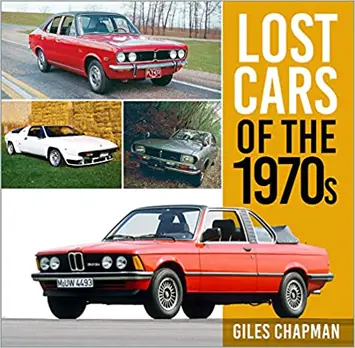Lost Cars of the 1970s by Giles Chapman – Review

By Dominic Picksley
As I heard the whine of the engine approaching, I rushed to the window to see my dad arrive home from work in his trusty Ford Anglia.
I looked on in wonderment, rather than amazement at the rust bucket that came to rest in front of our old home, but with a suspicious leaning, questioning myself whether this was a ‘cool’ car or not. It wasn’t.
And days later, I would be watching grandad cussing and swearing in his garage after something else had gone wrong on his prized Austin Allegro (and never was a car so undeserving of such a glamorous name).
These two cars I firmly associate with the 70s as a kid growing up in the wilds of Lincolnshire – along with Starsky and Hutch’s Gran Torino and Jim Rockford’s Pontiac Firebird – but neither of them get a mention in Giles Chapman’s excellent book, Lost Cars of the 1970s.
Quite rightly so, as production of the Ford Anglia ceased in 1969, while the Austin Allegro should remain forgotten, but there are many of the 60 cars included in this publication that will bring a wistful tear to the eye of dads and grandads around the country, which makes this book not only a coffee table staple, but also a must-buy Christmas present.
Chapman is one of the UK’s leading motoring writers and has published many books on the subject matter, but his latest release triggers plenty of memories from a time when car designers were pushing the boundaries, many seeing what whacky ideas they could come up with next.
Some, like the sleek, futuristic-looking Vauxhall SRV (1970), the exposed-wheels design of the Pininfarina Modulo (1971), the two-seater, six-wheeled Panther 6 (1977) and the aerodynamic Ford Ghia Action (1978) were basically vanity projects, few of which were produced and all which would have cost a small fortune to buy.
“Splendid tome”
 Not all the cars included have the wow factor, quite a few were practical family saloons, like the cumbersome Fiat 132 (1972), many of which became police cars and taxis; the leisurely Toyota Corolla Liftback E50 (1976), of which thousands were sold; the Vauxhall Derby (1977), basically, a longer and bigger version of the popular Golf; and the wedge-fronted Vauxhall Carlton (1978).
Not all the cars included have the wow factor, quite a few were practical family saloons, like the cumbersome Fiat 132 (1972), many of which became police cars and taxis; the leisurely Toyota Corolla Liftback E50 (1976), of which thousands were sold; the Vauxhall Derby (1977), basically, a longer and bigger version of the popular Golf; and the wedge-fronted Vauxhall Carlton (1978).
Chapman goes through his selections in chronological order, starting with 1970’s AMC Gremlin, one of the first-ever mini hatchbacks and a motor I would gladly have on my own drive today – but I wouldn’t say the same about the Bond Bug from the same year, a three-wheeled ‘commercial failure’ that was supposed to appeal to people in their early 20s, but was more likely to attract the over-70s crowd.
He concludes with the 1979-designed Bertone Volvo Tundra, a precursor of the Citroen BX, and the Italdesign Isuzu Asso Di Fiori, which became the Isuzu Piazza a year later.
In-between times, Chapman recalls a plethora of cars from around the world, providing their histories, detailed design analysis and why they never caught on or were stopped being made, all fascinating stuff.
He talks about the environmentally-friendly, pioneering Enfield 8000 (1974), which was an electric car, initiated by a Greek millionaire shipping magnate, who made his fortune – ironically – by transporting crude oil around the world. Go figure.
He gives a brief mention to the 1976 Bertone Alfa Romeo Navajo, a motor that you would half expect Buck Rogers to clamber out of, while he also includes the fabulous 1977 Pontiac Phantom, an engine-less mock-up created by legendary General Motors designer Bill Mitchell, that still survives today in a Detroit museum. Class.
But one of the strangest vehicles in the book is surely the 1974 Siva Llama, which came with the advertising slogan ‘There’s Nothing like It In The Country’. Quite. A kit car, with a Hillman Imp engine, which had removable sections and was designed to be used in remote destinations like the West Indies and the Middle East. It never caught on, unsurprisingly.
This is a just a splendid tome for car lovers and non-car lovers, alike, while I haven’t even mentioned motors produced by Lamborghini, Bentley, Buick, Aston Martin, Maserati and Mercedes-Benz, that are also featured. Lost gems indeed.
‘Lost Cars of the 1970s’ by Giles Chapman is published by The History Press









